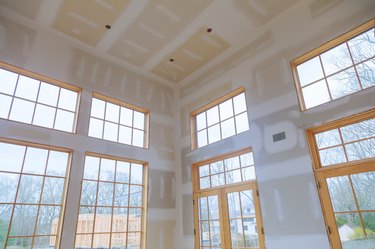
Drywall was born in 1916 as the war raged, a revolutionary product for easier construction and faster completion. The gypsum plaster sandwiched between paper exteriors ended the laborious practice of plaster and lathe, especially on ceilings, allowing contractors to bang a few nails and quickly finish a wall that might've taken days before. Today, drywall is omnipresent on every construction site, and its many options can be intimidating for the do-it-yourselfer. But the variety in drywall sizes, weights, and thicknesses should make your work simpler, not harder, since there's one that's right for nearly every job.
Tip
Drywall comes in many sizes, but the important question is, what sizes can you find without special-ordering? Most retailers keep stock limited to the most common size, 4x8 feet, which comes in a variety of thicknesses, as well as for many purposes.
Video of the Day
What to Know About Drywall Sizes
Drywall's purpose is to cover walls and make finishing them a cinch. They're ready for primer and a starring role in any room's look. This is why contractors try to use the largest size of drywall possible for the space. Drywall is easy to cut down to size, too — score the paper and plaster, and it should snap easily in place, eliminating the fear of getting something too large for a wall.
Video of the Day
But when you're considering drywall sizes, transporting the sheets, and getting them into place, is just as important as the space they're going in. After all, a 12-foot sheet isn't particularly stair-friendly.
The Most Common Sizes
Plywood sheets are usually 4-feet wide, but come in three lengths. Don't let that paper exterior fool you, though, because this stuff's heavy. Standard sheets clock in around 55 pounds each. The larger sheets are around 65 to 70, and 85-pounds-plus apiece, depending on brands, thicknesses, and lengths. Lightweight drywall can be up to 30 percent lighter, but you'll pay for that convenience.
Uncommon sizes are available from some manufacturers, with lengths up to 16 feet. The trouble is that it can be very hard to locate larger sheets in stock, frequently requiring special orders for lengths like 9, 14, or 16 feet. In fact, some retailers only carry 8-foot sheets. Also available, but less common, are 54-inch-wide boards, ideal for 9-foot-high ceilings, as hanging these horizontally makes for easy plastering between sheets.
- 4x8-foot sheets: This is the most common size of drywall in use and is the standard option for most residential jobs. Vertical and horizontal use are virtually interchangeable.
- 4x10-foot sheets: These sheets are handy for higher ceilings, eliminating a pesky putty seam high on the wall for ceiling lights to illuminate. It's also great for getting nice, smooth ceilings too.
- 4x12-foot sheets: The largest that plywood sheets come in, these are for use in large, long rooms where their size can get the job done better and faster.
The Usual Drywall Thicknesses
Purpose will dictate the right drywall thickness for your project.
- 1/4-inch drywall: When an aesthetic upgrade is in order, this thin sheeting can provide a clean, fresh finish to beat-up old walls. It's also somewhat pliable, making it the right way to go if you've got a subtle curve to clad on a wall.
- 3/8-inch drywall: Same as the 1/4-inch, this tends to be an aesthetic-repair choice where a little added heft can be of use — perhaps for additional sound-dampening over older drywall. It's also able to curve somewhat, but to a lesser effect.
- 1/2 drywall: Here's the standard thickness for most home construction. It has adequate sound-dampening and good strength, but isn't too heavy to hang. "Ultralight" 1/2-inch drywall is also available, around 13 pounds lighter versus the regular average sheet, making it easier for a DIY job — especially for end-of-day fatigue.
- 5/8-inch drywall: This is the thickest of the conventionally-available sizes, and is the go-to for sound-dampening and fireproofing in spaces that require that added element, like kitchens and game rooms.
A Product With Many Names
Drywall is the commonly used name, but this building innovation is referred to by a few names. "Sheetrock" is a popular brand that's now an everyday term, probably to the chagrin of its manufacturers — somewhat in the way that "Kleenex" can now mean any common tissue paper. Gypsum board is the generic name, and the Gypsum Association represents most American manufacturers. Some people shorten it to "gyprock" and "gyp board." Plasterboard is an older term bandied about still, and wallboard can refer to drywall, but also other panel-finishing room treatments.